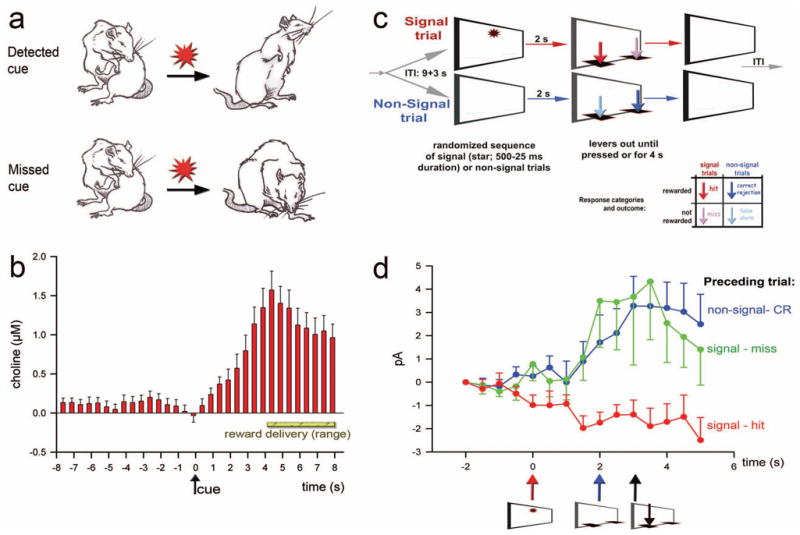Figure 1.

Prefrontal cholinergic transients mediating signal detection and attentional processing mode shifts. (a) Employing a cued appetitive response task, animals were trained to detect a rarely occurring cue that predicted reward delivery at one out of two reward ports (for details see [77]). Cue detection (as defined in the main text; [65]) was indicated by disengagement from ongoing behavior (typically grooming), orientation to and monitoring of the reward ports (see “detected cue”). As shown in (b) cues that were detected produced transient increases in cholinergic activity. No such transients were found in trials in which cues were missed. Importantly, reward was also delivered in such trials and thus animals eventually shifted from grooming behavior to port approach and reward retrieval. However, this was not associated with a cholinergic transient (for additional evidence and the effects of removal of prefrontal cholinergic inputs see [77]). (c) Main events of the sustained attention task (SAT). The task consists of a random sequence of signal and non-signal trials. Two seconds following an event the levers are extended, prompting the animal to report the presence or absence of a signal. Depending on the trial type, responses are classified as hits or misses and correct rejections or false alarms, respectively (see the color-coded response arrows in the outcome matrix). (d) Currents indicating ACh release in the prefrontal cortex during signal trials that yielded a hit (arrows indicate the time of signal presentation, lever extension, and correct lever press). Cholinergic transients were evoked by signals if the prior trial was a factual non-signal trial or a perceived non-signal trial (that is, a signal trial yielding a miss), but not if the prior trial also ended with a hit. Signals that resulted in misses never evoked transients, irrespective of the prior trial type (not shown; [78]) Collectively, these results indicate that prefrontal cholinergic transients mediate the shift from intrinsic or default-mode state-based activity to a state fostering signal detection. (a and b were reprinted from Neuron, Vol. 56, Parikh, V., Kozak, R., Martinez, V., Sarter, M., Prefrontal acetylcholine release controls cue detection on multiple time scales, p. 143 and 144. Copyright (2007) with permission from Elsevier.
